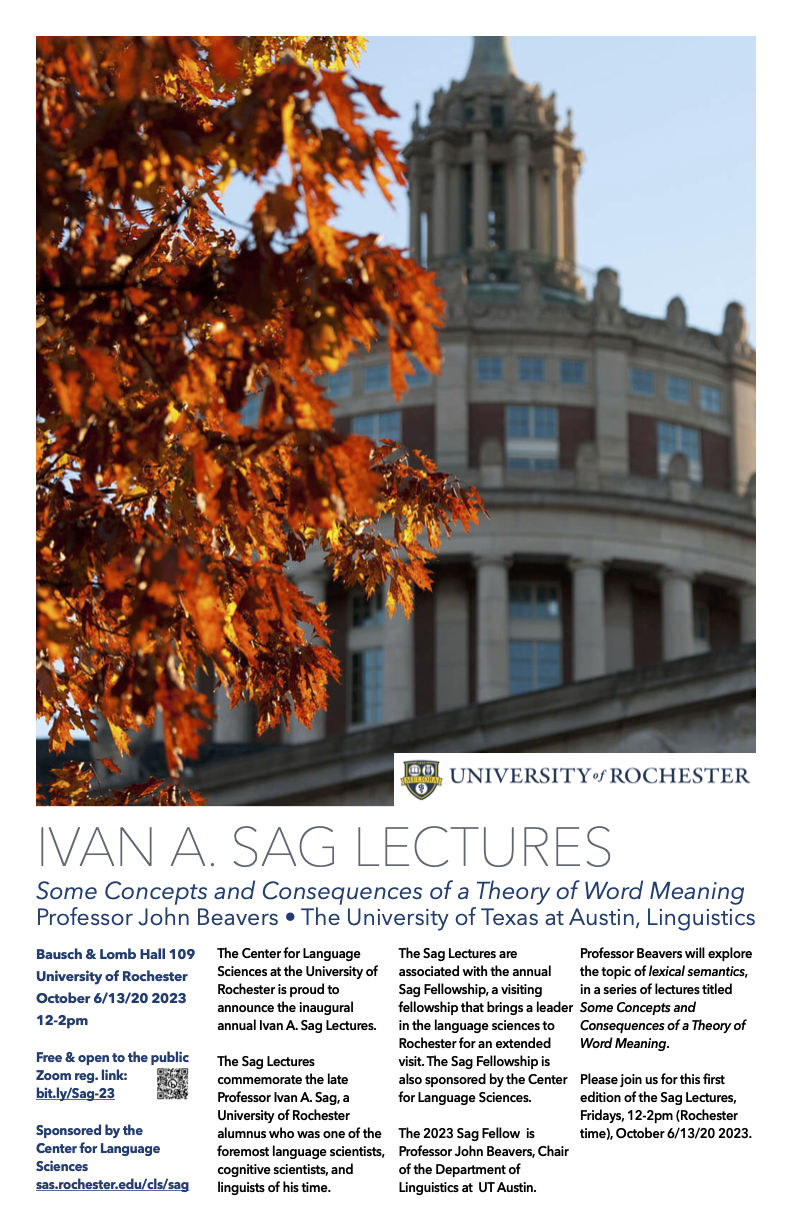Current Lectures
2023 Ivan A. Sag Lectures
Free & open to the public
Some Concepts and Consequences of a Theory of Word Meaning
Professor John Beavers
Chair & Robert D. King Centennial Professor of Liberal Arts
Linguistics•The University of Texas at Austin
Location
Bausch & Lomb Hall 109
University of Rochester
Interactive map
Printable map
Visitor parking
Times
12-2pm • October 6/13/20 2023
Shareable link
bit.ly/Sag-23

Downloadable tabloid-size PDF poster
Lecture 1
A Lexical Semanticist’s Apology
What is the meaning of a word? Is it some unanalyzable blob that you
simply memorize, or is it broken down into more basic pieces? If so,
what are those pieces, which are unique to each word and which are
shared across words, and how are those pieces put together to make up
the full meaning of a word? Are any combinations of pieces ruled out,
i.e. is there any such thing as an impossible word? And how does a
word’s meaning determine how it’s used in the grammar of a language?
Lexical semantics is the study of all of these questions, and in this
talk I survey various case studies — mostly drawn from the study of
verbs — that justify that word meanings are broken down into pieces
and that a theory of what those pieces are is necessary as part of a
larger theory of language, and I explore what some of the most basic
and widely accepted ingredients of such a theory are. By the end of
the talk we will have set the stage for exploring some central aspects
of lexical semantic theory in more depth in the following lectures.
Lecture 2
Lexical Representation, Lexical Semantics, and Syntax
Theories of verb meaning usually assume that verbs are organized in a
language’s vocabulary either in terms of the kinds of events or states
they describe, or else in terms of the kinds of entities that
participate in those events and states. These basic semantic concepts
are furthermore assumed to be organized into semantic structures —
events that are broken into subevents, or coherent casts of
participants — that determine what sorts of prefixes and suffixes a
verb takes and what sorts of other phrases it combines with, i.e. its
grammatical properties. In this talk I explore the ins and outs of
such theories. I suggest that in many cases the proposed semantic
structures are not motivated by anything other than the grammatical
properties they were meant to explain. I show instead that a theory of
a verb’s grammatical properties can instead be based on the actual
meanings of the words, i.e. what must be true of the world to even use
the word, and the ways word meanings contrast with one another. I also
explore several other factors that govern how words are used
grammatically, including pragmatics and common conventions of word
usage. The case studies I explore come from data on English,
Colloquial Sinhala, Bahasa Indonesian, and the Uto-Aztecan language
O’dam. I ultimately suggest that the relationship of word meaning to
grammar is governed by a soup of factors, but with actual meaning at
the heart of it all.
Lecture 3
Regular and Idiosyncratic Meaning in The Roots of Words
One of the most widely accepted facts about word meaning is that many
words share meaning in common, grouping words into classes, but that
within each class there’s something unique and idiosyncratic about
each word. It is commonly assumed that the grammar of a language only
“sees” the regular bits — the idiosyncratic parts of a given words
meaning are not really linguistically very significant, so much so
that studying their individual content is not likely to be very
fruitful. In this talk I explore this issue in detail, and suggest
that hidden within the idiosyncrasies of individual words are types of
regularity — sometimes the very same regularities that define whole
word classes — that are significant for how the word is used
grammatically. I draw on two primary case studies, one a broad,
typological study of the ways subtly different cause/effect scenarios
are described across a balanced sample of languages, and one on the
diverse patterns of expressions of giving in English and the Bantu
language Kinyarwanda. I conclude by suggesting that regularity and
idiosyncrasy are not so different from one another, and form more of a
continuum than a sharp division.
